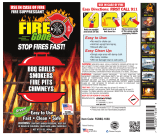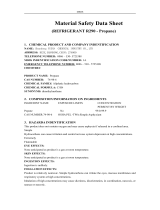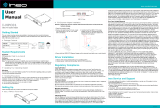
_________________________________________________________________________________________________
Date: November 12, 2012 KLEA®134a
Revision 4 Page 1 of 7
MATERIAL SAFETY DATA SHEET
1. CHEMICAL PRODUCT AND COMPANY IDENTIFICATION
Product Name: KLEA
®
134a
Product Use: Refrigerant
Alternate Names: Fluorocarbon 134a, R-134a, HFC-134a, HFA-134a
Manufacturer: Mexichem Fluor Inc.
4990B ICI Rd. / P.O. Box 30
St. Gabriel, LA 70776
Medical Emergency (24 hr.): 303-389-1418
Transportation emergency (24 hr.): CHEMTREC 703-527-3887 CODE: INEO
Product Information: (81) 8386-1705
Emergency: (81) 1482-0936
In Mexico In Case of a Chemical Emergency: Spill, Release, Fire, Explosion, or Accident
Call the SETIQ Day or Night
01-800-00-214-00 (call free from any place in Mexico)
or
01-55-59-15-88 (in Mexico City)
2. COMPOSITION/INFORMATION ON INGREDIENTS
Ingredients: %(Wt) OSHA PEL
1,1,1,2-tetrafluoroethane (CAS 811-97-2) 100 Not listed
3. HAZARD IDENTIFICATION
EMERGENCY OVERVIEW:
CAUTION! This product is a clear, colorless, liquefied gas. Contents under pressure.
Cylinders may rupture and rocket under fire conditions. Thermal decomposition can
produce toxic and corrosive gases. Vapors are heavier than air. May cause asphyxia.
Liquid splashes or spray may cause freeze burns (frostbite). High vapor concentrations
may cause dizziness or more severe anesthetic effects. Very high exposures can cause
potentially fatal abnormal heart rhythm. Read the entire MSDS for a more thorough
evaluation of the hazards.

_________________________________________________________________________________________________
Date: November 12, 2012 KLEA®134a
Revision 4 Page 2 of 7
POTENTIAL HEALTH EFFECTS:
Ingestion: Extremely unlikely to occur in use.
Eye contact: Liquid splashes or spray may cause freeze burns.
Skin contact: Liquid splashes or spray may cause freeze burns.
Skin absorption: This product will probably not be absorbed through human skin.
Inhalation: Exposure to high vapor concentrations can induce anesthetic effects progressing
from dizziness, weakness, nausea, to unconsciousness. Very high exposures can cause
abnormal heart rhythm, which is potentially fatal. It can act as an asphyxiant by limiting available
oxygen.
Other effects of overexposure: None expected.
4. FIRST AID MEASURES
Skin: Immediately wash with plenty of warm water (do not rub). Thaw affected area with water.
Remove contaminated clothing. Caution: clothing may adhere to the skin in case of freeze burns.
If symptoms (irritation or blistering) develop, get medical attention.
Eyes: Immediately flush with plenty of water. After initial flushing, remove any contact lenses and
continue flushing for at least 15 minutes. Hold eyelids open during flushing. Have eyes
examined and treated by medical personnel.
Ingestion: Highly unlikely, but should this occur, freeze burns will result. Do not induce vomiting
unless instructed to do so by a physician.
Inhalation: Move victim to fresh air. Keep warm and at rest. If breathing is labored, give oxygen.
If only breathing has stopped, give artificial respiration with a pocket mask equipped with a one-
way valve to prevent exposure to product or body fluids. If breathing has stopped AND there is
no pulse, give cardiopulmonary resuscitation (CPR). Get immediate medical attention.
Note to physician: Symptomatic and supportive therapy, as indicated. Administration of
epinephrine or similar sympathomimetic drugs should be with special caution and only in
situations of emergency life support as cardiac arrhythmias may result.
5. FIRE FIGHTING MEASURES
Flash Point: Does not flash.
Flammable Limits (Lower): Not applicable.
Flammable Limits (Upper): Not applicable.
Auto Ignition Temperature: > 743°C (> 1369°F)
Hazardous Reactions: Reacts with finely divided metals such as aluminum, zinc,
magnesium, and alloys containing more than 2% magnesium. Can react violently if in
contact with alkali metals and alkaline earth metals such as sodium, potassium, or barium.
During a fire the product can form toxic and corrosive gases such as hydrogen fluoride.
Fire and Explosion Hazards: Compressed liquefied gas. Containers may burst under
intense heat. Ruptured cylinders may rocket or fragment. Heavy vapor may suffocate.

_________________________________________________________________________________________________
Date: November 12, 2012 KLEA®134a
Revision 4 Page 3 of 7
HFC-134a is not flammable in air under ambient conditions of temperature and pressure.
Under conditions of high temperature and pressure, certain HFC-134a/air mixtures were
shown to be flammable. Certain mixtures of HFC-134a and chlorine may be flammable
under some conditions.
Extinguishing Media: As appropriate for surrounding materials/equipment.
Fire Fighting Procedures: Water spray should be used to cool containers.
Fire Fighting Protective Equipment: Use self-contained breathing apparatus with a full-
face piece and special protective clothing.
6. ACCIDENTAL RELEASE MEASURES
Contents under pressure. Ruptured cylinder may rocket or fragment. This product is a liquefied
gas, which exits the container at temperatures capable of causing freeze burns (frostbite).
Precautions should take into account the severity of the leak or spill.
Move unprotected personnel upwind of leaking container. Remove ignition sources and ventilate
the spill area. Use recommended personal protection and shut off the leak, if without risk. If
possible, elevate leak position to highest point of container (should leak gas, not liquid). Water
should never be put on leak nor should cylinder be immersed. If possible, dike and contain
spillage. Prevent liquid from entering sewers, sumps, or pit areas since vapor is heavier than air
and can create a suffocating atmosphere. Capture material for recycle or destruction if suitable
equipment is available.
Notify applicable government authority if release is reportable or could adversely affect the
environment.
7. HANDLING AND STORAGE
Handling: Wear appropriate personal protective equipment. A safety shower and eyewash
station should be nearby and ready for use.
This product is a liquefied gas, which exits the container at temperatures capable of causing
freeze burns (frostbite). Ensure personnel are trained in handling and storing cylinders.
Secure containers at all times. Keep containers closed when not in use.
Ensure there is adequate ventilation or use proper respiratory protection in poorly ventilated
or confined areas. Avoid causing and inhaling high concentrations of vapor. Atmospheric
levels should be controlled to below the occupational exposure limit and kept as low as
practicable.
Prevent liquid or vapor from entering sumps or sewers since vapor is heavier than air and
may form suffocating atmospheres.
Do not put mixtures of HFC-134a with air or oxygen under pressure; do not use such
mixtures for leak or pressure testing.
Do not heat containers.
Liquid transfers between containers may generate static electricity. Ensure adequate
grounding.

_________________________________________________________________________________________________
Date: November 12, 2012 KLEA®134a
Revision 4 Page 4 of 7
Avoid trapping liquid between closed valves or overfilling containers as high pressures can
develop with an increase in temperature.
Avoid HFC-134a contact with flames or very hot surfaces.
Storage Requirements: Keep containers tightly closed, in a cool, well-ventilated place.
Keep containers dry. Keep away from incompatibles, open flames, hot surfaces, welding
operations, and other heat sources.
Storage Temperature: Store at temperature not exceeding 125°F. (52°C.).
8. EXPOSURE CONTROLS/PERSONAL PROTECTION
EXPOSURE GUIDELINES:
INGREDIENT NAME: 1,1,1,2-Tetrafluoroethane
Mexichem Fluor Guideline 1000 ppm 8 hour TWA
WEEL (AIHA) 1000 ppm 8 hour TWA
No ACGIH TLV or OSHA PEL established.
Minimize exposure in accordance with good hygiene practice.
PREVENTIVE MEASURES:
Engineering Controls: Use ventilation to maintain safe levels. Where appropriate
engineering controls are not in place or are inadequate, wear suitable respiratory equipment.
PERSONAL PROTECTIVE EQUIPMENT:
Eye Protection: Use chemical safety goggles or safety glasses and a face shield when
there is potential for eye contact.
Skin Protection: Take all precautions to prevent skin contact. Use gloves and protective
clothing made of material that has been found by user to be impervious under conditions of
use to prevent the skin from becoming frozen from contact with liquid. User should verify
impermeability under normal conditions of use prior to general use. Additional protection
such as an apron, arm covers, or full body suit may be needed depending on conditions of
use.
Respiratory Protection: Not normally needed if controls are adequate. If needed, use
NIOSH/MSHA approved respirator for organic vapors. For high concentrations and oxygen-
deficient atmospheres, use positive pressure air-supplied respirator.
Other Protection: Shower and eye wash station.

_________________________________________________________________________________________________
Date: November 12, 2012 KLEA®134a
Revision 4 Page 5 of 7
9. PHYSICAL AND CHEMICAL PROPERTIES
Appearance: Clear, colorless liquified gas
Boiling point: -15.1°F., -26.2°C.
Vapor pressure (mmHg at 20°C.): 4270
Vapor density (air = 1): 3.6
Solubility in water: Very low
pH: Not applicable
Specific gravity: 1.22 at 20°C.
% Volatile by volume: 100
10. STABILITY AND REACTIVITY
Chemical Stability: Stable under normal conditions.
Incompatibility: Reacts with finely divided metals such as aluminum, zinc, magnesium, and
alloys containing more than 2% magnesium. Can react violently if in contact with alkali
metals and alkaline earth metals such as sodium, potassium, or barium.
Hazardous Decomposition Products: Hydrogen fluoride by thermal decomposition and
hydrolysis. Oxides of carbon and fluoride may be produced by thermal decomposition.
Conditions to Avoid: Keep away from heat, sparks, and flame. Avoid high temperatures.
Hazardous polymerization: Will not occur.
11. TOXICOLOGICAL INFORMATION
POSSIBLE HUMAN HEALTH EFFECTS:
Inhalation: High atmospheric concentrations may lead to anesthetic effects, including loss of
consciousness. Very high exposures may cause an abnormal heart rhythm and prove suddenly
fatal. Higher concentrations may cause asphyxiation due to reduced oxygen content of the
atmosphere.
Ingestion: Highly unlikely, but should this occur, freeze burns will result.
Eye contact: Liquid splashes or spray may cause freeze burns.
Skin contact: Liquid splashes or spray may cause freeze burns.
Other effects: None anticipated.
Carcinogenicity: None of the ingredients are classified as carcinogenic by IARC, ACGIH, NTP,
or OSHA.
ANIMAL DATA:
LC
50
: 4 hr. (inh., rat) = > 500,000 ppm
Slight eye irritation resulted from a brief spray of vapor.
The material was a slight skin irritant, but not a skin sensitizer.
The threshold for cardiac sensitization (arrhythmias) in dogs pretreated with epinephrine was an
atmosphere of 75,000 ppm. The no observed effect level (NOEL) was 50,000 ppm.

_________________________________________________________________________________________________
Date: November 12, 2012 KLEA®134a
Revision 4 Page 6 of 7
No effect of any kind was seen in a 90-day inhalation study in the rat at dose levels up to, and
including 50,000 ppm (6 hours per day, 5 days per week).
No developmental effects were seen in the rabbit following inhalation exposure to 40,000 ppm
during gestation despite slight maternal toxicity. In a range-finding study in the rabbit, possible
minimal embryo lethality was seen at a dose level of 50,000 ppm. In the rat, slight fetotoxicity
was present at an inhalation dose of 50,000 ppm administered during gestation and no effects
were seen at 10,000 ppm. In another study in the rat, no developmental effects were seen at a
dose of 100,000 ppm in the presence of slight maternal toxicity; clear maternal effects were
followed by embryo toxicity and fetotoxicity at a dose level of 300,000 ppm. There were no
increases in the incidence of fetal malformations in rats or rabbits at doses up to and including
300,000 ppm and 50,000 ppm, respectively.
HFC-134a showed no genetic toxicity in a range of in-vitro and in-vivo tests. No adverse effects
were found in a study in which rats were followed to week 104 after receiving 300 mg/kg
bodyweight/day of HFC-134a by gavage for 52 weeks. In a 2-year inhalation study in rats, no
adverse effects of any kind were observed except increased incidences of non-life threatening,
benign, microscopic testicular interstitial (Leydig) cell tumors and associated interstitial cell
hyperplasia which were confined to the top dose of 50,000 ppm.
12. ECOLOGICAL INFORMATION
Ecotoxicological Information: Daphnia 48 hour EC50: 980 mg/l. Rainbow trout 96 hour LC50:
450 mg/l.
Persistence and Degradation: Decomposes comparatively rapidly in the lower atmosphere
(troposphere). Atmospheric lifetime is 14 years. Products of decomposition will be highly
dispersed and hence will have a very low concentration. It is not a significant contributor to
photochemical smog and is not considered to be a VOC. Is not considered an ozone-depleting
chemical.
Effect on Effluent Treatment: Discharges of the product will enter the atmosphere and will not
result in long-term aqueous contamination.
13. DISPOSAL CONSIDERATIONS
Disposal Method: Discarded product is not a hazardous waste under RCRA, 40 CFR 261.
However, HFC-134a should be recycled, reclaimed, or destroyed whenever possible.
Container Disposal: For disposable (DOT 39) cylinders only. Do not distribute, make available,
furnish, or reuse container when emptied of the original product. Open valve to remove pressure
in the cylinder. Then puncture, drill, crush, or otherwise destroy empty cylinder and dispose of in
a facility permitted for nonhazardous waste. Return all other containers to supplier.
Refrigeration Application: Subject to "no venting" regulations of Sections 608 and 609 of the
Clean Air Act during the service or disposal of equipment.

_________________________________________________________________________________________________
Date: November 12, 2012 KLEA®134a
Revision 4 Page 7 of 7
14. TRANSPORT INFORMATION
DOT Hazard Description:
Proper Shipping Name: 1,1,1,2-tetrafluoroethane or Refrigerant gas R 134a
Hazard Class: 2.2
Identification Number: UN 3159
Packing Group: None
Hazardous Substance (RQ): None
Placard/Label: Non-Flammable gas
15. REGULATORY INFORMATION
TSCA (Toxic Substances Control Act) Regulations, 40 CFR 710: All Ingredients are on the
TSCA Chemical Substances Inventory.
CERCLA and SARA Regulations:
40 CFR 372: This product does not contain any chemicals subject to reporting requirements of
SARA Section 313.
40 CFR 355: This product does not contain any "extremely hazardous chemical" subject to the
requirements of SARA Section 312.
40 CFR 370: Hazardous properties as defined under the Hazard Communication Standard (29
CFR 1910.1200)
Health: Acute effects (CNS depression, cardiac sensitization).
Physical: Compressed liquefied gas.
(Actions may be necessary under SARA Section 311 – consult regulations for applicability).
16. OTHER INFORMATION
The information herein is given in good faith, but no warranty, expressed or implied, is made.
-
 1
1
-
 2
2
-
 3
3
-
 4
4
-
 5
5
-
 6
6
-
 7
7
Ask a question and I''ll find the answer in the document
Finding information in a document is now easier with AI
Related papers
Other documents
-
Summit FFBF191SSIM MSDS Information
-
Summit FFBF191SSIM MSDS R134a C
-
HDX 20128HDX User manual
-
 Fire Gone fg-007-102 Installation guide
Fire Gone fg-007-102 Installation guide
-
Summit FF31L7SS MSDS Information
-
 Kegco TCK-1B-4 Specification
Kegco TCK-1B-4 Specification
-
 Ineo Tech I-NPC01 User guide
Ineo Tech I-NPC01 User guide
-
Karnak 505MS-CTG User manual
-
Summit SCR1400WLH MSDS Information
-
Summit SCR611GLOS Material Safety









